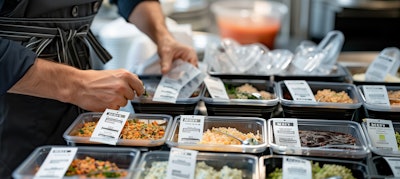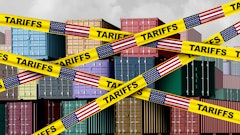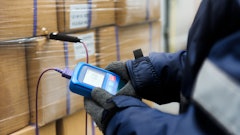
It’s no secret that brands are buzzing about the new addition to the Food Safety Modernization Act (FSMA), Rule 204.
At its core, FMSA 204 tightens the leash on recordkeeping in the food industry, requiring brands to increase traceability documentation to ultimately reduce food contamination issues and improve public health – two goals all food brands share.
But here’s the thing: in food safety, compliance is tablestakes, not the ace up your sleeve.
Between mounting public pressures, a backlog of internal processes and procedures, and looming compliance changes, food brands need a new way to scale sustainably.
And item-level traceability serves as an exciting foundation for that growth.
By embracing item-level traceability, food producers and distributors can meet FSMA 204 requirements and unlock new operational efficiency, all while reducing risk at each juncture of the supply chain.
Here’s how you can move beyond compliance and get strategic with traceability.
What’s the big deal about FSMA 204?
Born from a decade of food safety evolution, FSMA 204 isn’t just another regulation—it’s the FDA’s answer to a fragmented supply chain. Finalized in 2022 and effective January 2026, this rule targets high-risk foods like leafy greens, cheeses, and nut butters, mandating granular tracking from farm to fork.
The FDA’s goal? To flip the script on foodborne illness outbreaks. By requiring companies to trace products “one step forward, one step back,” FSMA 204 transforms recall timelines from weeks to days.
So, when contaminated baby spinach or recalled deli meat makes headlines, this rule gives brands precision to isolate issues—protecting consumers and profit margins.
Public perception of this new rule splits like a fresh-baked baguette:
● Some industry veterans see high compliance costs and operational headaches—think upgraded software, retrained staff, and supplier coordination.
● Consumers and advocates cheer it as overdue progress. According to a survey by Purdue University, 72% of grocery shoppers consider transparency "extremely important" when choosing brands and retailers.
But FSMA 204 isn’t about playing regulatory roulette. Brands leveraging item-level traceability (think batch-specific QR codes or RFID tags) are building recall-resistant reputations and supply chains sharp enough to slice through future regulations—or a dicey news cycle.
Public concern for food safety is on the rise
These days, food safety has dominated the news cycle, and not in the most flattering way.
While recall data from the FDA shows that there hasn’t necessarily been an increase in recalls issued, there certainly has been more news attention on the subject.
The reality is these headlines ensnare doubt in consumers.
According to the International Food Information Council’s 2024 survey, customer confidence in food safety has plummeted—reaching its lowest levels in a decade.
The study unearthed that Americans are “extremely concerned” about a variety of food-related toxins:
● 32% cite extreme concern about E. coli in ground beef
● 29% worry about metals and toxins like lead, cadmium, and arsenic in baby food
● 27% fret over mercury in seafood
Your customers want to understand the journey of the food you sell them, so getting granular (down to the item level) with your inventory is just good business.
Why item-level traceability is a game-changer for food brands
Traditionally, the most visibility brands could get into their inventory at any point in the supply chain was at the pallet or lot level.
Depending on the goods, hundreds of individual items could be within each pallet.
With item-level traceability, you can track every single item, providing unparalleled visibility into your supply chain.
Here’s why it matters:
Minimizes the impact of large-scale recalls
Contamination is an important risk for food brands, but item-level traceability helps mitigate that concern.
Say, for example, a store detected a lettuce contamination. With item-level traceability, that store could pinpoint the exact heads of lettuce affected down to the specific farm, harvest time, shipment, and route.
Precision like this minimizes the scope of the recall, saving the store money and protecting its brand reputation.
Improves your data (and decisions)
Your supply chain is only as healthy as the data that powers it.
Companies (and, now, regulatory bodies via FSMA 204) always search for new ways to perfect and clean their data to ensure they have the best information to make the right decisions.
But for many food companies, clear, reliable data can feel like a—costly—indulgence.
Add in all the new data points required by FSMA 204, like Critical Tracking Events (CTEs) and Key Data Elements (KDEs), to an incomplete or broken ecosystem, and all those metrics won’t do you (or your customers) any good.
Item-level traceability forces you to standardize and automate data collection, ensuring accuracy and consistency.
High-quality data isn’t just good for compliance—it’s a goldmine for operational insights. For example, you can identify bottlenecks in your supply chain, optimize inventory management, and even predict potential risks before they become problems.
Strong data also protects you financially. Gartner found that poor data quality costs companies an average of $12.9 million annually.
The role of data quality in recalls
Food recalls are a constant threat that companies today must contend with, and the difference between a minor hiccup and a full-blown disaster often comes down to data quality.
If your data is incomplete or inaccurate, you’ll waste precious time figuring out what went wrong instead of solving the problem.
On the other hand, clean, well-organized data allows you to act quickly and decisively. For example, during a recall, you can use your traceability system to:
● Identify the source of contamination
● Determine which products are affected
● Notify customers and regulators in real-time
This level of responsiveness not only minimizes harm but also demonstrates your commitment to food safety.
Unlocks end-to-end operational efficiency
Item-level traceability isn’t just about compliance or damage control—it’s a tool for dissecting inefficiencies buried deep in your supply chain.
While pallet-level tracking leaves you guessing about individual SKUs, granular visibility exposes hidden costs and opportunities at every touchpoint.
This type of tracking solves many inefficiencies, including manual labor bottlenecks. RFID and IoT sensors automate inventory counts, reducing human error and freeing staff for value-added tasks like quality checks.
Real-time tracking can also clear up inventory blind spots by locating “ghost inventory” (products lost in warehouses) and prevent global food waste caused by overstocking/spoilage.
Tracking this granular also helps brands decrease transportation waste. For example, GPS-enabled devices reveal inefficient routes, helping companies save on transportation vessels, fuel, labor, and other costs.
The intel it delivers is groundbreaking:
● Process mapping. Spot recurring delays (e.g., 48-hour lag at customs for Peruvian avocados) and renegotiate contracts with slow partners.
● Supplier scoring. Rate vendors on freshness metrics (e.g., leafy greens arriving at 34°F vs. 41°F) to reward top performers.
● Predictive analytics. Real-time, item-level tracking software enables brands to leverage data to make smarter decisions across the supply chain.
When FSMA 204 takes effect in 2026, these optimized operations will separate market leaders from those still untangling spreadsheets.
Builds consumer trust
Today’s consumers aren’t just buying food—they’re buying values. Close to 72% of grocery shoppers now prioritize transparency about ingredients and production methods when choosing brands. And, despite inflation, shoppers are even willing to pay a 9.7% premium for sustainable goods.
This shift stems from recurring food safety scandals, ethical concerns about labor practices, and growing climate awareness—issues making headlines weekly.
Item-level traceability transforms vague claims into verifiable proof. By embedding technologies like QR codes or RFID tags, brands let customers scan packaging to see:
● Farm locations with geotagged harvest timestamps
● Temperature logs from refrigerated transport
● Sustainability certifications for ingredients
● Labor welfare audits at production facilities
For example, a brand could use an RFID-powered system to track produce from orchards to restaurant prep stations, displaying harvest dates and farmer profiles via in-store QR codes, so consumers could see where their food comes from at the point of purchase.
Why data like this matters now (and tomorrow):
● Recall resilience. 53% of consumers lose trust in brands for months after recalls, with some citing avoiding those brands altogether after a public recall or major safety concern.
● Consumer demands. Responsible sourcing is becoming a mainstay for customers. One survey found that 83% of people would pay more for goods that were ethically sourced. Brands can show this journey in unique ways, like QR codes on packaging to showcase fair-trade partnerships, carbon-neutral shipping, and more.
● Regulatory foresight. The EU’s Digital Product Passport (2027) will require farm-to-fork data disclosure—early adopters gain market advantage.
As you can see, the benefits of item-level traceability extend well past regulatory requirements to improve your operational efficiency, decision-making, and consumer trust and loyalty.
Item-level traceability is the future; it’s time to invest
For enterprises, implementing an item-level traceability system will require time, effort, and strategic resources. That endeavor might feel daunting at first.
But think about what you’d be giving up:
● Lower risk of costly, large-scale recalls
● Well-oiled supply chain
● Stronger relationships with suppliers, partners, and customers
● Competitive advantage in a transparency-minded marketplace
● Safeguard against regulatory misconduct
2026, and the advent of FSMA 204 will be here before we know it. Food brands should see this call for increased transparency as an invitation to create a safer, more resilient food system.
And that vision starts where it ends—with each individual item of food.
So, what are you waiting for? Start your traceability journey today and turn compliance into a catalyst for growth.



















